Lockheed RM-81 Agena
The Agena space vehicle was used in large numbers during the 1960s and 1970s as upper stage with SLV-2 Thor, SLV-3 Atlas and SLV-5 Titan boosters to launch a variety of military and civilian payloads into orbit. The Agena itself was actually the first general-purpose satellite, and formed the core for many operational satellites and experimental space vehicles. It is included in this missile directory, because the U.S. Air Force allocated the formal missile designator RM-81 to the Agena (see section on Designations for details).
In 1955, the U.S. Air Force began its WS-117L program, calling for the development of a strategic satellite system. The initial primary goal of WS-117L was the development an orbital photo-reconnaissance platform, and in June 1956, Lockheed became prime contractor for the system. The core element of WS-117L was a new multipurpose spacecraft with boost and manoeuvering engines, which would act as the second stage of the launch vehicle as well as the carrier vehicle for the reconnaissance system. Lockheed's Agena spacecraft was built around the Bell XLR81 liquid-propellant rocket engine, and was initially known informally as Hustler, because the XLR81 was originally developed for a (later cancelled) rocket-powered weapons pod for the B-58 Hustler bomber. The first launch of a Thor-Agena combination on 28 February 1959 was a failure, but on 13 April that year, Agena scored its first success when a Thor-Agena launcher placed the Discoverer 2 satellite into polar orbit.
Agena A
The first few Agenas, including the vehicle used in the Discoverer 2 launch, used a Bell XLR81-BA-3 (Bell Model 8001) rocket engine, but most vehicles of the initial Agena A series used an XLR81-BA-5 (Bell Model 8048). The engine had gimballed nozzles for pitch and yaw control, and could deliver a thrust of 68.9 kN (15500 lb) for up to 120 s.
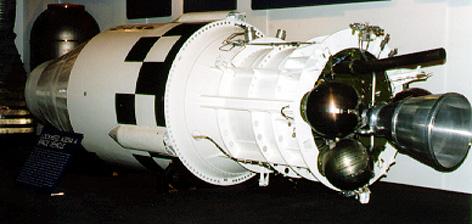 |
| Photo: © Mark Wade, Encyclopedia Astronautica |
| Agena A |
| Launch Vehicle Combination | Number of Launches | First/Last Launch |
|---|---|---|
| Thor (SLV-2) + Agena A | 16 | 21-Jan-1959 / 13-Sep-1960 |
| Atlas (LV-3A) + Agena A | 4 | 26-Feb-1960 / 31-Jan-1961 |
| Total for Agena A | 20 | 21-Jan-1959 / 31-Jan-1961 |
Launch summary for Agena A
The Thor-Agena A launched the initial reconnaissance satellites of the CORONA (publicly named Discoverer) series (KH-1 camera system), while the Atlas-Agena A was used for the first two launches of both the MIDAS (Missile Detection And Surveillance) early-warning system and SAMOS reconnaissance satellite series.
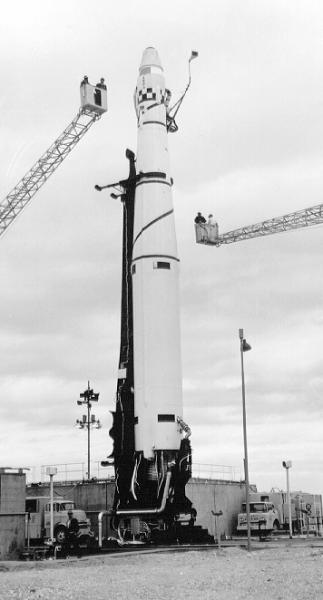 |
 | |
| Photos: via Jonathan McDowell's collection | ||
| Thor-Agena A (Discoverer 6) | Atlas-Agena A (MIDAS 2) | |
Agena B
The Agena B had an improved XLR81-BA-7 engine (Bell Model 8081), which could be restarted in space, and was stretched to carry much more propellant, doubling the total burn time to 240 s. Both features greatly increased the versatility of the Agena vehicle. When launched into low orbits, the Agena B had plenty of fuel left for extensive orbital manoeuvers, an important requirement for a reconnaissance platform. Later models of the Agena B used a further improved XLR81-BA-9 (Bell Model 8096) engine, which (among other changes) increased the thrust to 71.1 kN (16000 lb) by using a different type of fuel.
| Launch Vehicle Combination | Number of Launches | First/Last Launch |
|---|---|---|
| Thor (SLV-2) + Agena B | 44* | 26-Oct-1960 / 28-Aug-1964 |
| Thrust-Augmented Thor (SLV-2A/C) + Agena B | 3* | 29-Jun-1963 / 15-May-1966 |
| Atlas (LV-3A) + Agena B | 28 | 12-Jul-1961 / 21-Mar-1965 |
| Atlas (SLV-3) + Agena B | 1 | 9-Jun-1966 |
| Total for Agena B | 76 | 26-Oct-1960 / 9-Jun-1966 |
Launch summary for Agena B
* Thor variant counts slightly differ between sources, but Thor-Agena total is not in question
Most of the Thor-Agena B vehicles launched CORONA series reconnaissance systems (all of the KH-2/3 camera systems, and some systems of the KH-4 and KH-5 series). The Atlas-Agena B launched a variety of spacecraft, the major ones being MIDAS early-warning systems, SAMOS reconnaissance systems and Ranger space probes.
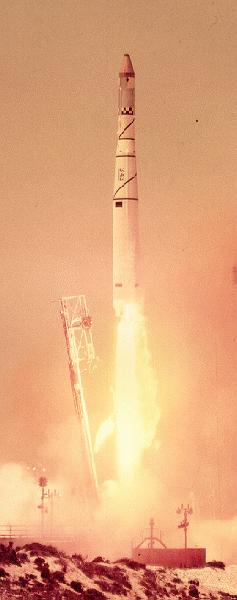 |
 | |
| Photos: via Jonathan McDowell's collection | ||
| Thor-Agena B (SLV-2) (SAMOS-F2 2) | Atlas-Agena B (LV-3A) (SAMOS 3) | |
Agena C
The designation Agena C was reserved for a proposed enlarged variant, which was to have doubled the capability of the Agena B (most likely by doubling the fuel tank size). However, this version was not built.
Agena D
The majority of Agenas were of the final Agena D variant. This was essentially a "standardized" Agena B, which could accept a variety of payloads (in a conical payload section in the nose) and be fitted to Atlas, Thor or Titan launchers without changes to the basic Agena. The earlier Agena A/B vehicles were tailor-made for their respective payloads and launcher types. The Agena D also used the Bell Model 8096 engine, mostly a slightly improved version initially designated XLR81-BA-11, and later YLR81-BA-11. The Agena D launched a large number of military and scientific payloads, including e.g. the Gemini-Agena target vehicles used by NASA for space capsule docking experiments in 1966.
 |
| Photo: NASA |
| Gemini-Agena D |
| Launch Vehicle Combination | Number of Launches | First/Last Launch |
|---|---|---|
| Thor (SLV-2) + Agena D | 22* | 28-Jun-1962 / 31-May-1967 |
| Thrust-Augmented Thor (SLV-2A/C) + Agena D | 60* | 28-Feb-1963 / 17-Jan-1968 |
| LTTAT** (SLV-2G/H) + Agena D | 22* | 9-Aug-1966 / 16-Jul-71 |
| Thorad (SLV-2G/H) + Agena D | 21* | 18-May-1968 / 25-May-72 |
| Atlas (LV-3A) + Agena D | 15 | 12-Jul-1963 / 20-Jul-1965 |
| Atlas (SLV-3) + Agena D | 48 | 14-Aug-1964 / 5-Nov-1967 |
| Atlas (SLV-3A) + Agena D | 12 | 4-Mar-1968 / 7-Apr-1978 |
| Atlas F + Agena D | 1 | 27-Jun-1978 |
| Titan 3B † (SLV-5B) | 29 | 29-Jul-1966 / 23-Oct-1970 |
| Titan 23B †† | 2 | 21-Jan-1971 / 22-Apr-1971 |
| Titan 33B †† | 3 | 21-Mar-1971 / 21-Aug-1973 |
| Titan 24B †† | 23 | 12-Aug-1971 / 21-Aug-1973 |
| Titan 34B †† | 11 | 10-Mar-1975 / 12-Feb-1987 |
| Total for Agena D | 269 | 28-Jun-1962 / 12-Feb-1987 |
Launch summary for Agena D
* Thor variant counts slightly differ between sources, but Thor-Agena total is
not in question
** LTTAT = Long-Tank Thrust-Augmented Thor (quoted by some sources as identical to Thorad)
† Titan 3B was the designation for the Titan 3 + Agena D combination
†† These derivatives of the Titan 3B are sometimes called 3(23)B, 3(33B), 3(24)B and 3(34)B, respectively.
The majority of Agena D missions on Thor-type boosters launched CORONA reconnaissance systems - mostly KH-4/4A/4B camera systems, but also KH-5 (ARGON) and KH-6 (LANYARD). Most of the initial Atlas-Agena D vehicles (LV-3A/SLV-3) launched GAMBIT-1 satellites (KH-7 reconnaissance system) into orbit, but payloads also included the Mariner series of interplanetary probes and the GATV (Gemini-Agena Target Vehicle). The SLV-3A/Agena D was used to launch the CANYON and RHYOLITE/AQUACADE series of SIGINT satellites into geostationary orbits.
 |
 |
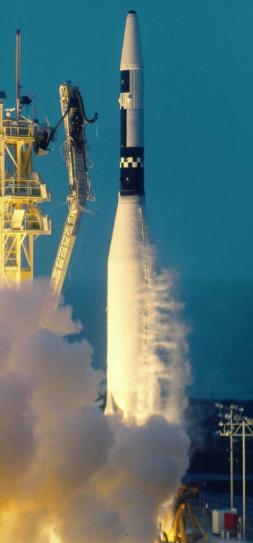 | ||
| Photos: via Jonathan McDowell's collection | ||||
| TAT-Agena D (SLV-2A) (OGO 4) | Thorad-Agena D (SLV-2G) (Nimbus 3 + SECOR 13) | Atlas-Agena D (SLV-3) (Snapshot + SECOR 4) | ||
The Titan 3B/23B/24B series launched GAMBIT-3 (KH-8 reconnaissance system) satellites, while the payloads of the larger Titan 33B/34B boosters consisted of JUMPSEAT SIGINT and SDS communications satellites.
 |
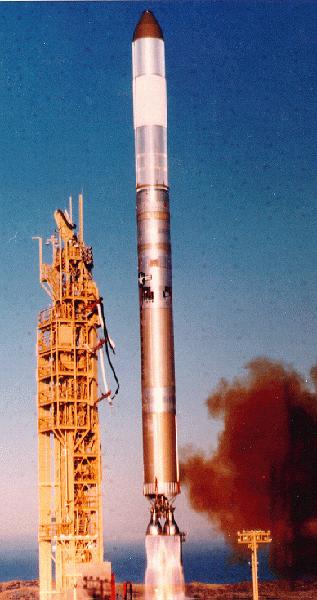 | |
| Photos: via Jonathan McDowell's collection | ||
| Titan 3B (SLV-5B) (KH-8 19) | Titan 34B (Jumpseat 6) | |
A total of 365 Agena vehicles of all types were launched into space by the U.S. Air Force and NASA between January 1959 and 12 February 1987, when the last Agena D was launched with an NRO payload (SDS communications satellite #7) as upper stage of a Titan 34B booster.
Designations
RM-81
In 1958 (or early 1959), the U.S. Air Force allocated the formal "Reconnaissance Missile" designation RM-81 to the Agena space vehicle. The reasons for this remain unclear, but the USAF possibly needed to assign a designator for formal purposes and there was no better alternative at that time. USAF serial number listings show a total order of 341 Agenas, designated as XRM-81, RM-81, SRM-81 and SRM-81A. Because I cannot connect these four designators in any way to the documented basic Agena variants (Agena A/B/D), I don't know what the significance of the different RM-81 designations is. The table below is a detailed listing of allocated Agena serial number blocks, sorted by type designation:
| Serial Range | Designation | Total Number Ordered |
|---|---|---|
| 59-2544/2557 60-606/615 60-5454/5463 60-6594/6630 60-6914/6922 62-12585 | XRM-81 | 81 |
| 60-3710/3719 | RM-81 | 10 |
| 63-7368/7406 63-12759/12764 65-10657/10685 66-4390/4432 66-9249/9262 67-14544/14579 | SRM-81 | 167 |
| 61-4530/4536 62-3876/3878 62-4614/4625 62-12202/12213 62-12289/12291 63-13040/13085 | SRM-81A | 83 |
Notes:
- The Agena did not receive a new designation in June 1963, when the joint DOD missile designation system was introduced, because spacecraft were not originally part of the new system.
- One would expect that SRM-81A designated a newer version than SRM-81 (before 1962, an "A" suffix designated the second version), but the latest blocks are all attributed to plain SRM-81. However, after June 1963 the Agena's designation was no longer covered by any official regulation, so it's possible that the general SRM-81 designator was not meant to designate any specific variant, but was only retained in the serial number list for informal purposes.
- The 341 serials do not account for the full number of Agenas built (at least 365).
XRS-1
Some Air Force missile inventory records mention the designation XRS-1, most likely connected in some way to the Agena program. XRS may or may not stand for "Experimental Reconnaissance Satellite". When examining the records in detail, they say that the USAF acquired a total of five XRS-1 vehicles between May 1963 and June 1964. By March 1965, none were left, with two being listed as "Mission Completed" (one between October and December 1963, and one between January and March 1964) and the other three as "Tested to Destruction" (between January and March 1965). There is no obvious way to connect these data to a specific USAF satellite program of that time.
S-01
For some time in the 1960s, the Air Force used the basic designation S-01 for Agena. The "S" apparently stood for "Stage", and "SS" for "Standard Stage" - similar to "(S)LV" for "(Standard) Launch Vehicle".
| Designation | Agena Model |
|---|---|
| S-01 | Agena B |
| S-01A | Agena D |
| SS-01A | Agena D |
| S-01B | Agena D |
| SS-01B | Agena D |
| S-01C | Gemini-Agena |
Notes:
- No information is available on the differences between the S-01A, SS-01A, S-01B and SS-01B Agena D variants.
- The S-01C had an engine with multiple restart capability, designated XLR81-BA-13.
Specifications
Note: Data given by several sources show slight variations. Figures given below may therefore be inaccurate! Because exact numbers for each Agena depend on payload configuration, the data are to be regarded as "typical" values.
Data for Agena A, Agena B, Agena D:
| Agena A | Agena B | Agena D | |
|---|---|---|---|
| Length | 5.94 m (19.5 ft) | 7.56 m (24.8 ft) | |
| Diameter | 1.52 m (5 ft) | ||
| Weight | 3850 kg (8500 lb) Fuel: 2945 kg (6500 lb) | 7160 kg (15800 lb) Fuel: 6115 kg (13500 lb) | |
| Propulsion | Bell XLR81-BA-5 liquid-fuel rocket; 68.9 kN (15500 lb) for 120 s |
Bell XLR81-BA-9 liquid-fuel rocket; 71.1 kN (16000 lb) for 240 s |
Bell YLR81-BA-11 liquid-fuel rocket; 71.1 kN (16000 lb) for 240 s |
Main Sources
[1] Jos Heyman: "World Spacecraft Digest 1957-2002", Tiros Space Information, 2003
[2] Jos Heyman: "Spacecraft Tables 1957-2002", Tiros Space Information, 2003
[3] René J. Francillon: "Lockheed Aircraft since 1913", Putnam, 1987
[4] Norman J. Bowman: "The Handbook of Rockets and Guided Missiles", Perastadion Press, 1963
[5] Mark Wade: Encyclopedia Astronautica
[6] Gunter Krebs: Gunter's Space Page
[7] USAF Aircraft Serial Number Records (data provided by Jos Heyman)
[8] Curtis Peebles: "The CORONA Project", Naval Institute Press, 1997
Back to Directory of U.S. Military Rockets and Missiles, Appendix 1
Last Updated: 19 August 2025